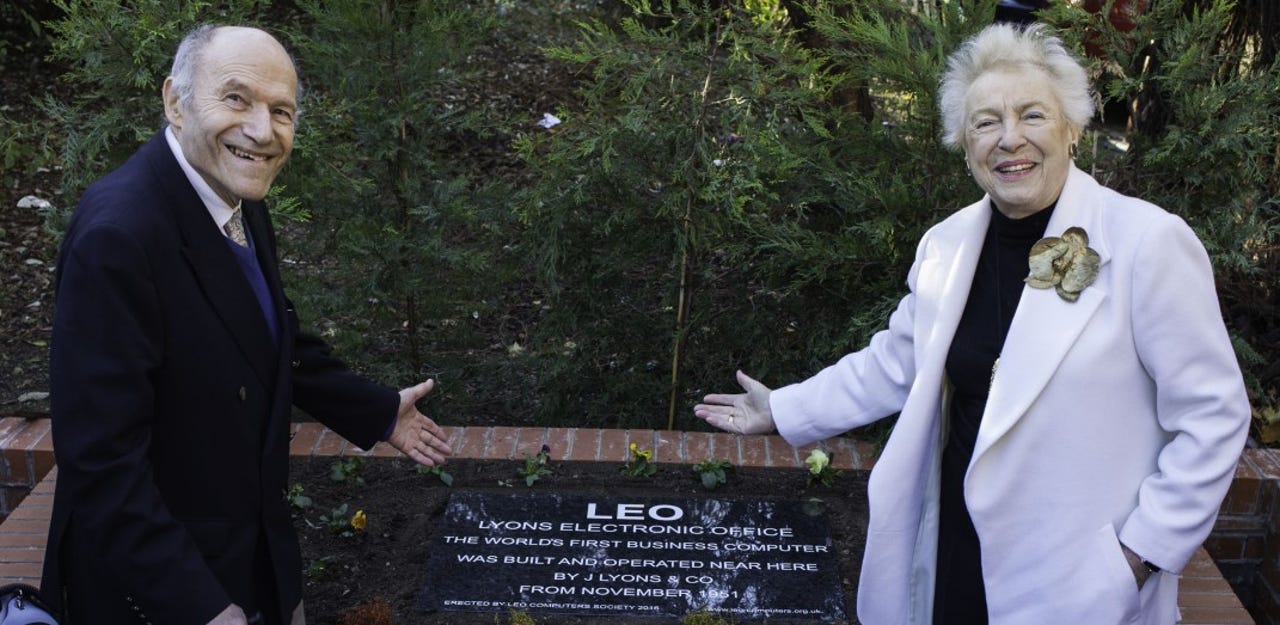LEO, the world's first business computer, commemorated with a plaque in London


Frank Land and Dame Stephanie Shirley unveil a plaque to mark the site of the world's first business computer, which ran its first production programs 65 years ago.
A plaque has been installed in Hammersmith, west London, where Lyons, the tea-shop company, ran the world's first electronic business computer 65 years ago. Nothing remains of Cadby Hall, the two-acre site where Lyons had its head office, several bakeries, and an ice cream factory: it was demolished in 1983. Lyons hasn't survived either. However, a plaque now marks the site where the LEO (Lyons Electronic Office) computer pioneered business computing in 1951.
The plaque was unveiled by LEO pioneer Frank Land and Dame Stephanie Shirley, who was the world's first freelance programmer. Professor Land joined Lyons in the 1950s after graduating from LSE, while Steve Shirley (born Vera Buchthal) worked at the Post Office Research Station at Dollis Hill, building computers and writing code in machine language. Both were born in Germany and migrated to the UK as children to escape the Nazis.
Lyons was a forward-looking company and its researchers were familiar with ENIAC, the computer built for the US Army to calculate shell trajectories. Later they learned that Professor Maurice Wilkes was building a computer, EDSAC, at the University of Cambridge. They gave him some money and hired a Cambridge graduate, John Pinkerton, who became the LEO's engineering manager.
The LEO at Cadby Hall - an expanded and enhanced version of EDSAC - had around 6,000 valves (vacuum tubes) in 21 racks, and occupied roughly 5,000 square feet. It was sufficiently interesting that Princess Elizabeth visited the site to look at LEO being tested in February 1951. It ran continuously until January 1965.
Many large companies wanted their own LEO, and in 1954, Lyons set up LEO Computers Ltd to supply them. Users included Ford, Shell, Dunlop, Ever Ready, the Royal Bank of Scotland and some insurance companies, as well as HM Dockyards, HM Customs & Excise and the Inland Revenue. LEO also exported computers to Australia, South Africa, and Czechoslovakia.
LEO's own high-level language was cleverly called CLEO, which stood for Clear Language for Expressing Orders.
However, LEO Computers was unable to compete in a growing market that was soon dominated by IBM. It was merged into English Electric LEO in 1963, and in 1968, it became part of ICL, which eventually merged most of the British computer industry. ICL was taken over by Fujitsu in 1990, though it retained the ICL branding until 2002.
LEO lives on through the efforts of the LEO Computers Society.
This year, English Heritage also installed a blue plaque in Hammersmith to honour the company founder Joseph Lyons (1847-1917). He opened his first tea-shop in London in September 1894.